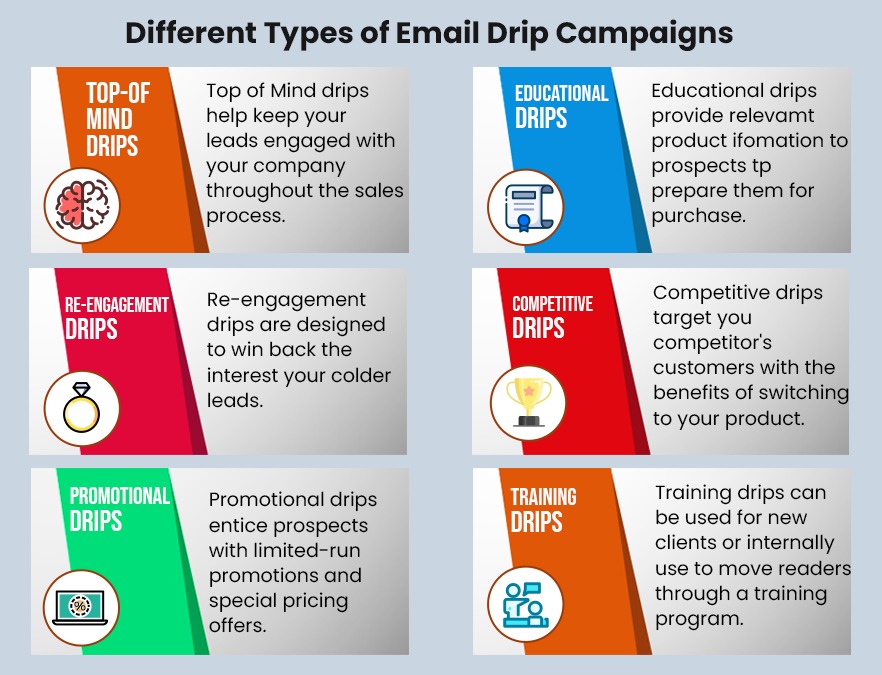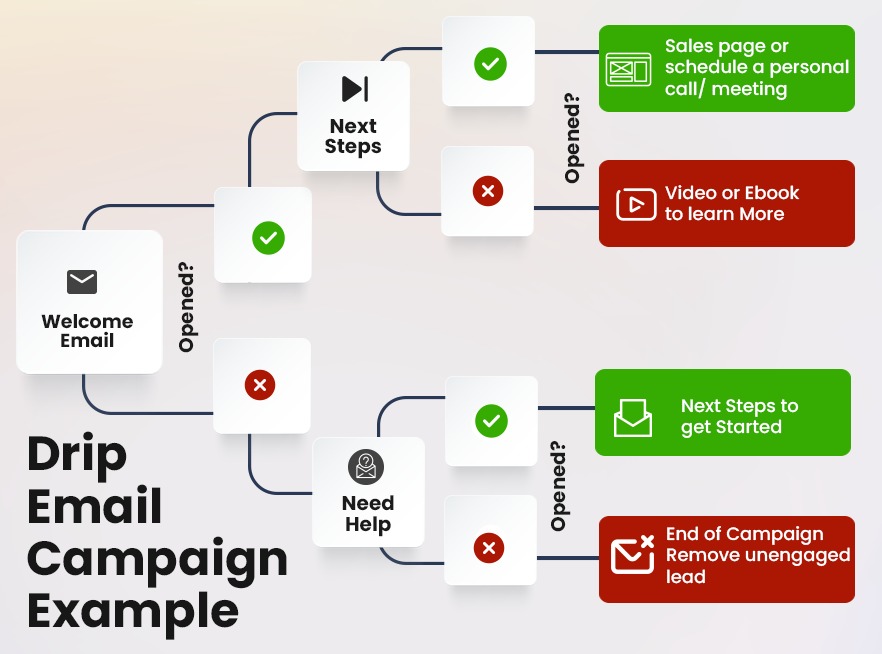
In a perfect world, your audience would see one of your advertisements and immediately convert, purchasing the product or opting in for a service. In reality, however, the typical customer journey is far less linear. There are numerous touchpoints between the initial targeting of a customer and conversion – known as the lead cycle. The duration of an average lead cycle varies greatly; it can be as short as a few days for a low-research CPG product (consumer packaged goods) to as long as a few years for a high-investment B2B product. How do you sustain your audience’s attention throughout the span of their purchase journey? This is where drip email marketing comes in.
What is drip email marketing?
Drip email marketing is the technique of sending out a series of emails based on specific triggers. For example, as soon as a customer is added to the database, a welcome email will be automatically sent out. If a customer adds a product to their shopping cart but doesn’t checkout, a reminder email will be sent to them to complete the purchase. Contrast this with a regular email marketing campaign where a single email is sent out to the entire customer database. In this case, there is little to no personalization and the campaign usually ends with this single email as there are no follow-ups.
Drip email marketing is the technique of sending out a series of emails based on specific triggers. It has a high degree of personalization.

Benefits of Drip Email Campaigns
While a drip email marketing campaign does require a little more planning than single-email campaigns, it can offer several powerful benefits:
- Drip emails often achieve higher engagement rates as they are personalized for each recipient
- Since they continuously engage with customers, they can improve sales. In fact, one report found that companies using drip campaigns can see up to 80% higher sales
- They are less effort-intensive than other forms of lead nurturing, for example, manual follow-ups with leads through the phone. This can result in almost 33% higher cost saving
- By offering informative content catered to a user’s requirements, drip emails can build higher authority and trust among customers.
These advantages prove that drip campaigns aren’t simply an add-on feature of your overall marketing strategy, but a pivotal part of it.
Also read: On-Page vs Off-Page SEO: Your Quick Guide To its Business Value
How to build a successful drip email campaign
Creating a personalized email marketing campaign for your customers and leads can sound like a time-consuming undertaking, but fortunately, it only requires a one-time effort. Here’s how you can get started building an effective drip campaign.

The first step to creating a drip email sequence is categorizing the customer groups you want to nurture. You can do this by identifying the major sources of leads or sign-ups. For example, your company could be getting customer information from the following sources:
- Blog newsletter sign-ups
- Social media ad campaigns
- Website enquiries
- Purchases on your website
Each of these groups of customers will have different requirements and will be in different stages of the buying journey. Once you have your unique customer groups, you need to decide what the end goal for each will be. For example, a lead/user who has responded to your ad campaigns will need to be nurtured until they convert. A customer who has already purchased from your website before will need to be shown related products and offers so they can make repeat purchases. Identifying the end goal for each group is essential because this will help streamline all communication that is sent to them.
2. Decide on what triggers to use
Triggers are where the real power of automation comes into play in your drip campaigns. An automatic email is sent out when a user completes a specific trigger, therefore you don’t need to manually send emails each time. There are a number of triggers you can set up and they often vary based on each customer group. Some of the triggers you can use include:
- Completed form fills
- Product added to cart
- Clicks on specific links or buttons on the website
- Getting added to a list
Once you have a defined set of triggers, you can start creating specialized emails that will be sent out for each of them.
3. Create unique emails for each trigger
Now comes the part where you can unleash your creativity! The actual emails themselves are the most important part of the drip campaign and so it’s crucial that you get the content right. Here are some important tips for creating your drip emails:
Decide on a workflow: The email sequence needs to be carefully planned out so you know the exact emails you need to create. Some drip campaign examples include a welcome mail, introduction to your company and products, informative articles or thought leadership blogs, and a thank you mail for when the desired action (eg. purchase) is completed. The exact automatic emails to be sent will have to be customized for your target audience and product. For example, drip campaign examples for cart abandonment include timely reminders about the product, special offers to encourage purchase, and recommendations of similar products.
4. Personalize every mail:
Personalization is the key to higher engagement with customers. Drip emails in themselves are a form of personalized marketing as the email sequence is tailored for each user group. However, you can personalize emails even further with details like the person’s name, their company, the region they’re from, etc. A good email marketing tool will offer customizable fields that can automatically pull information from the lead database.
5. Consider the design of your emails:
A good design will complement the content of your emails, making them more visually pleasing for the user. Every email does not have to have a unique design, you can use design templates and simply change the content. Some email campaign tools also offer free customizable templates so you don’t need a dedicated designer for your campaigns. You don’t always need a design for your emails though. In some cases, especially B2B emails, even a text-only email can work very well as it can appear a lot more personal.
6. Set a schedule for your emails
In many cases, particularly lead nurturing journeys, there won’t be a specific user-driven trigger every time. For example, a user might enquire in an ad, triggering the first automatic email in a drip campaign, but might not take any action after this. So does this mean that no further emails will be sent out? Clearly, for a drip email campaign to effectively nurture a lead, emails need to be sent out at regular intervals even if there is no trigger. You can set a specified schedule for each automatic email in your drip campaign. It is important, however, to get the timing of your emails right. Emails sent too frequently can get you blocked as spam, while emails sent out too sparingly can fail to build any recall among customers. A good frequency is to send out just one email per week, but this can vary depending upon your business area.
7. Monitor and optimize your campaign performance
One of the benefits of a drip campaign is that it’s a largely ‘set and forget’ marketing activity but this doesn’t mean it requires no monitoring at all. You should periodically analyze open rates and click-through-rates to understand the efficacy of your campaigns.
If your campaigns are repeatedly getting low opens, then you will need to tweak your subject line to resonate with customers better. If, on the other hand, you notice a decent open rate but very low link clicks, you will need to modify the content and design of the emails to make them more engaging. You should also regularly check the quality of your customer database and clean it up. If your campaigns are consistently getting low opens despite modifications, the fault may lie in the quality of the database. In this case, you might even have to alter the targeting of your ads and messaging on the website to attract a more relevant audience.
Drip email campaigns are the final clinching step in your overall marketing campaigns. They can nurture leads generated, encourage customer loyalty and strengthen relationships with existing customers. The long-term approach that drip campaigns offer can help distinguish your brand from competitors and deliver consistent rewards over time.
Do you need help setting up and managing drip email campaigns for your business? Talk to our email specialists to get an answer.

Karen Jain
Karen brings her decades-long experience in content and digital marketing to helping global brands to showcase their expertise. When she isn’t writing or caught up in being a digital marketing evangelist, you will find her passionately involved in animal rescues.









